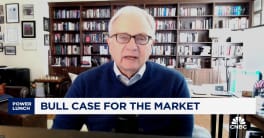Mortgage loan delinquencies continued to rise in the third quarter according to information released on Thursday by the Mortgage Bankers Association (MBA).
Loans on one-to-four unit family homes that were delinquent, but not yet in foreclosure, reached 9.64 percent of all loans during the third quarter. This is an increase of 40 basis points over the second quarter of 2009, breaking the all time record set at that time. The rate is 265 basis points higher than the 6.99 percent delinquency rate reported one year ago.
- 3.57 percent of all loans were 30 days past due compared to 3.68 percent last quarter and 3.39 percent one year ago.
- 1.67 percent of all loans were 60 days delinquent compared to 1.68 percent and 1.40 percent on year ago
- Seriously delinquent loans - those over 90
days or in foreclosure represented 4.41 percent of loans compared to 3.88
percent last quarter and 2.75 percent during the third quarter of 2008.
The differences in delinquency rates between prime and subprime loans are staggering. Nationally, 6.94 of all prime loans are 30 or more days past due and an additional 3.20 percent are in foreclosure. This means that even for prime loans, over ten percent of homeowners are having problems paying their mortgages. However, 26.66 percent of subprime loans are at least 30 days delinquent and another 15.35 percent are in foreclosure. Thus, 42.01 percent of subprime loans are in trouble.
Still, it is prime loans and FHA loans that are driving the increases in foreclosure while delinquencies in subprime loans may have started to level off. 33 percent of the foreclosures initiated during the quarter were on prime, fixed-rate loans and those FRMs represented 44 percent of the total increase in foreclosures initiated during the quarter. This situation will probably continue to deteriorate as prime fixed-rate loans represented 54 percent of the increase in seriously delinquent (over 90 days) loans.
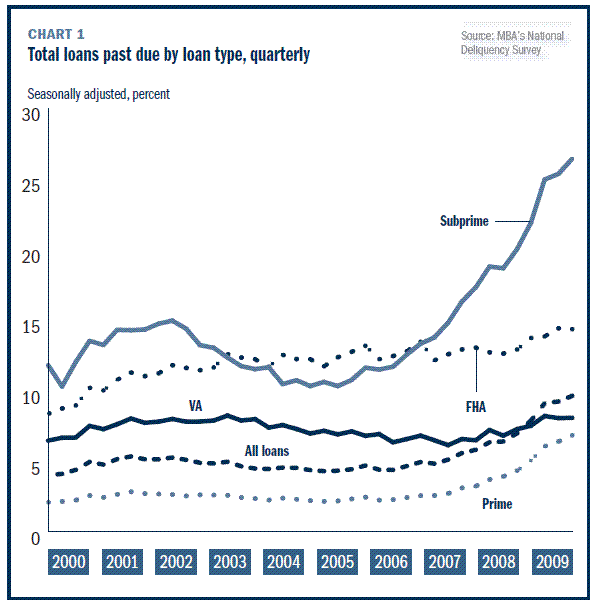
On a regional basis, the South has the most delinquent loans at 10.59 percent followed by the North Central states (9.89 percent,) the West (9.53 percent,) and the Northeast (8.98 percent.) Serious delinquencies and foreclosures were highest in the West at 9.81 percent, and the South at 8.99 percent. The North Central and Northeast regions had 8.19 percent and 7.51 percent of their loans falling into those categories.
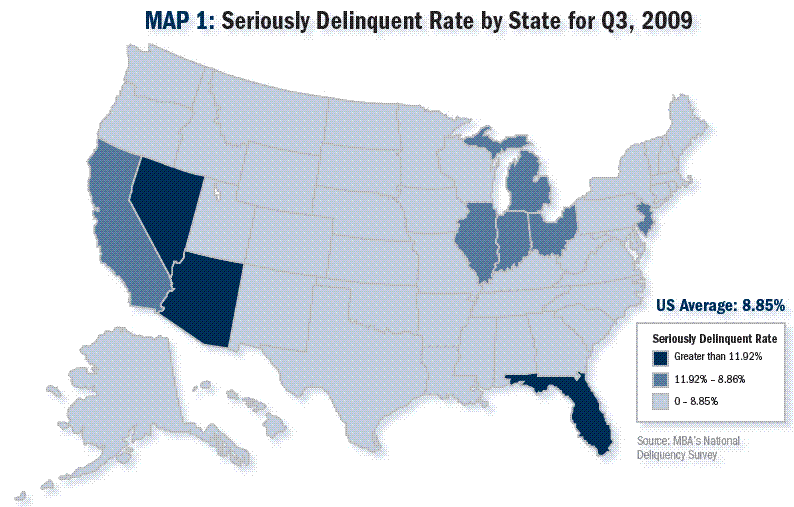
Loans for which foreclosure was initiated during the quarter reached 1.42 percent, added to the 4.47 percent that were already in the legal system. During the second quarter there were 1.36 percent of loans added to the 4.30 percent in the system. A total of 8.85 percent of loans are either seriously delinquent or in foreclosure compared to 5.17 percent one year ago.
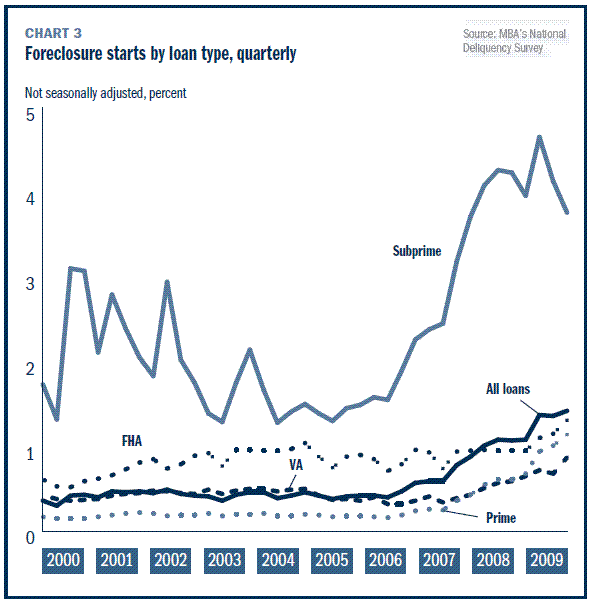
FHA loans also saw an increasing rate of foreclosures even though the universe of those loans has increased by 1.1 million new loans in the past year. Including those new loans in the foreclosure equation means a rate of 1.31 percent for FHA loans. However, if it is assumed that it is not these new loans that are defaulting and remove them from the calculation, the FHA foreclosure rate is 1.76 percent compared to 1.15 percent in the second quarter and 0.95 in the third quarter of 2008.
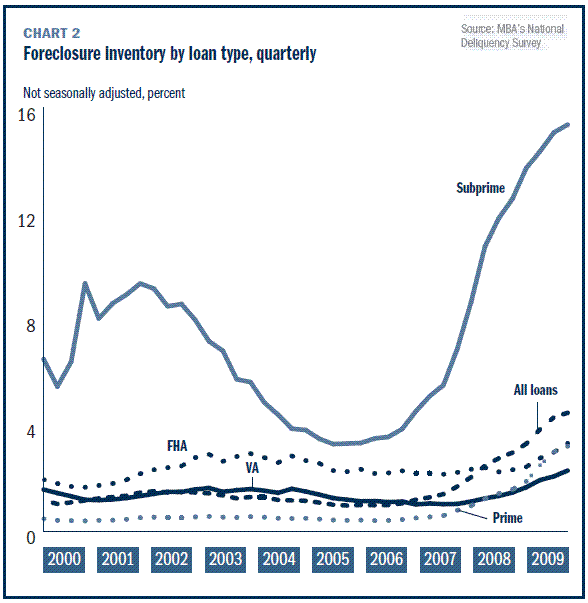
Florida, California, Arizona, and Nevada continue to have a disproportionate share of the nation's foreclosures. The four states represented 43 percent of all legal action initiated in the third quarter; 37 percent of prime FRM foreclosures and 67 percent of prime ARM actions. At the end of the quarter (September) one-quarter of all mortgages in Florida were at least one month behind in mortgage payments.
The foreclosure rate for prime adjustable rate mortgages (ARMs) exceeded the rate for subprime FRMs for the first time during the quarter while both subprime FRMs and ARMs saw decreases in foreclosures.
Jay Brinkmann, MBA's chief economist said, "Despite the recession ending in mid-summer, the decline in mortgage performance continues. Job losses continue to increase and drive up delinquencies and foreclosures because mortgages are paid with paychecks, not percentage point increases in GDP. Over the last year, we have seen the ranks of the unemployed increase by about 5.5 million people, increasing the number of seriously delinquent loans by almost 2 million loans and increasing the rate of new foreclosures from 1.07 percent to 1.42 percent."
"The outlook is that delinquency rates and foreclosure rates will continue to worsen before they improve. First, it is unlikely the employment picture will get better until sometime next year and even then jobs will increase at a very slow pace. Perhaps more importantly, there is no reason to expect that when the economy begins to add more jobs, those jobs will be in areas with the biggest excess housing inventory and the highest delinquency rates. Second, the number of loans 90 days or more past due or in foreclosure is now a little over 4 million as compared with 3.9 million new and previously occupied homes currently for sale, although there is likely some overlap between the two numbers. The ultimate resolution of these seriously delinquent loans will put added pressure on the hardest hit sections of the country."




